In an increasingly digital world, tapping into your creative side whether you’re into journaling, painting, or photography remains an essential way to express yourself.
Being creative is an incredible way to unleash and manage emotions so you can look after yourself on stressful days, which is why the benefits of igniting artistic talents should never go unnoticed.
With National Creativity Day on May 30th, why not reflect on what it means to be creative at every stage of life. Whether you’re a young person at the start of a career, a busy mom, or a retired person keen to start drawing again, this guide explores the value in having a life-long love affair with creativity.
Rewarding Benefits of Self-Expression
Mental and Emotional Wellbeing
It is well documented that creating art, in every form, can play a significant role in boosting your mental health, improving well-being, and enhancing other parts of your everyday life. Engaging in art can improve mood, increase self-esteem and foster a sense of purpose while being an effective tool for managing stress.
Art therapy has been recognized as a therapeutic practice since the mid-20th century and has proven particularly effective for individuals dealing with trauma, anxiety, and depression. Creative practices can provide a safe outlet for processing difficult emotions while helping you to navigate relationships. Journaling is a further therapeutic tool where artistic expression can support you through life’s challenges.
Focussed Attention and Sensory Connection
Even in practices like portrait photography, as MPB highlights, the mind-body connection in creative expression is evident. Being present and connecting with your subject enhances images while also fostering calm and focus for the photographer. Just as marveling at a child’s first drawing, your grandfather’s garden sketches, or a friend’s portfolio, encouraging creativity across a lifetime is invaluable.
In education, arts have long been lauded for promoting cognitive, social, and emotional improvements in students. One study found that after improving arts there was a 3.6% reduction in disciplinary incidents and an improvement of 13% in writing scores. Nurturing creativity at school is a useful pathway to understand a young person's mindset and what they might be trying to express outside the parameters of traditional lessons or subjects.
Likewise, even towards the end of life, creativity offers profound comfort for both those in hospice care and caregivers. Regardless of age, ability, or circumstance, art can be a rewarding two-way process to help cope with grief, celebrate life, and forge meaningful connections at all stages of life.
Embracing Arts in the Age of AI
Despite the initial apprehension that AI might replace human creativity in the future, recent scholarly studies agree that it’s healthier to embrace emerging technology and apply it to your creative projects at work or in your leisure time. Evolving algorithms in AI can generate images, music, and text with remarkable sophistication without diminishing the beauty, intelligence or worth of your art in whatever form it takes. Rather than fearing the tools, learn how to augment them to come up with journal entries, imaginative images, or original pieces.
Moreover, while AI can analyze patterns and produce outputs based on data, it can’t replicate real feelings, create art from lived experience, or depict heartfelt emotions. Your creativity, in contrast, is inherently individual and shaped by your personal background, culture, education, relationships and sensations experienced in unique situations. Each creation deserves a special acknowledgment for its unique merits.
Carving out a Personal Legacy
Surveys have shown that one in three of us would like to be remembered for our creativity. One of the loveliest parts of collecting art within your family home or elsewhere is the power it has to leave a legacy that can span generations, time, and geographical boundaries. Your creativity is also life’s stories, that may shape and inspire future generations.
Similarly, works of personal art become a treasure trove for future members of your family and friends to remember you by. With that said, it’s important to lovingly look after that portrait of a loved one, a photo of your favourite pet, or those personal memoirs collated from years of journaling. The entries you write today might bring comfort to loved ones decades from now, while films of an infant’s first steps are key moments in time that could otherwise fade from memory.
By recognizing what makes you creative and continuing to nurture that spark throughout your life, you build a personal legacy that reflects your unique journey and place in the world. This collection of creative works—whether published or shared with those closest to you all become a testament to your distinctive way of seeing and experiencing life.
As you celebrate National Creativity Day, embrace your passions, record magical moments, and start to express inspirational thoughts in a journal. Embracing a lifetime of creative expression can be reframed as a new super-power to fuel personal development, support challenging times and support your well-being at every stage of life, now and in years to come.
ABOUT THE AUTHOR
Annie Button is a freelance writer specialising in well-being and sustainable lifestyles. Her work features on leading online sites and publications, where she explores practical solutions to fast-paced contemporary living.
https://www.anniebutton.co.uk


Leave Comment